英语专业论文-英文论文我国文化产业国际竞争力研究
- 格式:doc
- 大小:73.50 KB
- 文档页数:19
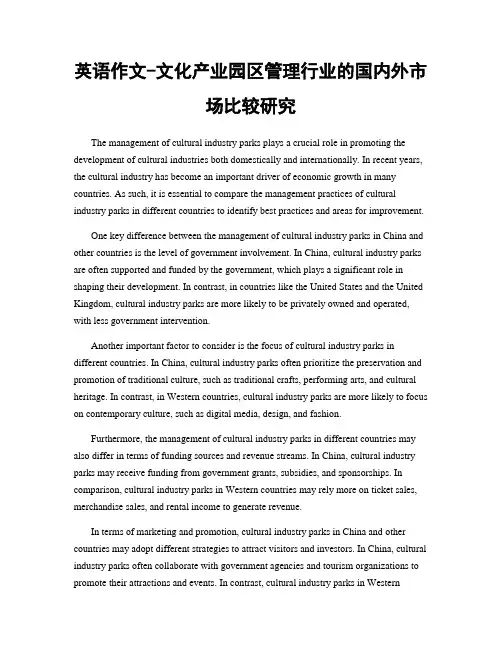
英语作文-文化产业园区管理行业的国内外市场比较研究The management of cultural industry parks plays a crucial role in promoting the development of cultural industries both domestically and internationally. In recent years, the cultural industry has become an important driver of economic growth in many countries. As such, it is essential to compare the management practices of cultural industry parks in different countries to identify best practices and areas for improvement.One key difference between the management of cultural industry parks in China and other countries is the level of government involvement. In China, cultural industry parks are often supported and funded by the government, which plays a significant role in shaping their development. In contrast, in countries like the United States and the United Kingdom, cultural industry parks are more likely to be privately owned and operated, with less government intervention.Another important factor to consider is the focus of cultural industry parks in different countries. In China, cultural industry parks often prioritize the preservation and promotion of traditional culture, such as traditional crafts, performing arts, and cultural heritage. In contrast, in Western countries, cultural industry parks are more likely to focus on contemporary culture, such as digital media, design, and fashion.Furthermore, the management of cultural industry parks in different countries may also differ in terms of funding sources and revenue streams. In China, cultural industry parks may receive funding from government grants, subsidies, and sponsorships. In comparison, cultural industry parks in Western countries may rely more on ticket sales, merchandise sales, and rental income to generate revenue.In terms of marketing and promotion, cultural industry parks in China and other countries may adopt different strategies to attract visitors and investors. In China, cultural industry parks often collaborate with government agencies and tourism organizations to promote their attractions and events. In contrast, cultural industry parks in Westerncountries may focus more on digital marketing, social media, and partnerships with cultural institutions and brands.Overall, while there are differences in the management of cultural industry parks in China and other countries, there are also opportunities for cross-cultural exchange and collaboration. By studying and learning from each other's practices, cultural industry parks can enhance their management strategies and contribute to the sustainable development of the cultural industry on a global scale.。
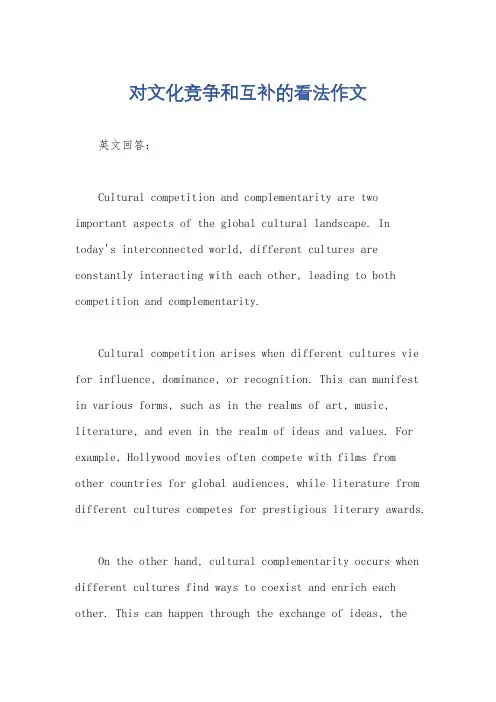
对文化竞争和互补的看法作文英文回答:Cultural competition and complementarity are two important aspects of the global cultural landscape. Intoday's interconnected world, different cultures are constantly interacting with each other, leading to both competition and complementarity.Cultural competition arises when different cultures vie for influence, dominance, or recognition. This can manifest in various forms, such as in the realms of art, music, literature, and even in the realm of ideas and values. For example, Hollywood movies often compete with films fromother countries for global audiences, while literature from different cultures competes for prestigious literary awards.On the other hand, cultural complementarity occurs when different cultures find ways to coexist and enrich each other. This can happen through the exchange of ideas, theblending of traditions, or the fusion of artistic styles. For instance, the popularity of fusion cuisine, which combines elements from different culinary traditions, demonstrates how cultures can complement each other to create something new and exciting.In my opinion, cultural competition and complementarity are not mutually exclusive, but rather they coexist and interact with each other. Competition can drive innovation and creativity, pushing cultures to strive for excellence and uniqueness. At the same time, complementarity allowsfor the cross-pollination of ideas and the enrichment of cultural expressions.For example, the rivalry between different fashion capitals like Paris, Milan, and New York drives designers to push the boundaries of creativity, resulting in avibrant and diverse fashion landscape. On the other hand, the fusion of traditional and modern dance styles in contemporary dance performances showcases how different cultural elements can complement each other to create compelling and dynamic art forms.Overall, cultural competition and complementarity are essential for the dynamism and evolution of global culture. They propel cultural exchange and dialogue, leading to the enrichment and diversity of the human experience.中文回答:文化竞争和互补是全球文化领域中两个重要的方面。
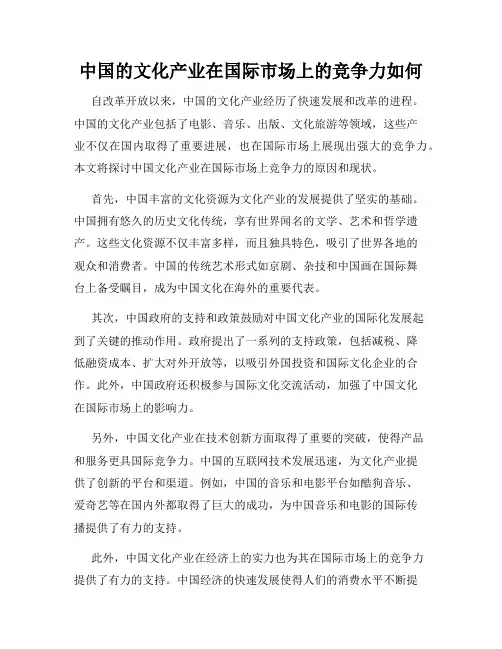
中国的文化产业在国际市场上的竞争力如何自改革开放以来,中国的文化产业经历了快速发展和改革的进程。
中国的文化产业包括了电影、音乐、出版、文化旅游等领域,这些产业不仅在国内取得了重要进展,也在国际市场上展现出强大的竞争力。
本文将探讨中国文化产业在国际市场上竞争力的原因和现状。
首先,中国丰富的文化资源为文化产业的发展提供了坚实的基础。
中国拥有悠久的历史文化传统,享有世界闻名的文学、艺术和哲学遗产。
这些文化资源不仅丰富多样,而且独具特色,吸引了世界各地的观众和消费者。
中国的传统艺术形式如京剧、杂技和中国画在国际舞台上备受瞩目,成为中国文化在海外的重要代表。
其次,中国政府的支持和政策鼓励对中国文化产业的国际化发展起到了关键的推动作用。
政府提出了一系列的支持政策,包括减税、降低融资成本、扩大对外开放等,以吸引外国投资和国际文化企业的合作。
此外,中国政府还积极参与国际文化交流活动,加强了中国文化在国际市场上的影响力。
另外,中国文化产业在技术创新方面取得了重要的突破,使得产品和服务更具国际竞争力。
中国的互联网技术发展迅速,为文化产业提供了创新的平台和渠道。
例如,中国的音乐和电影平台如酷狗音乐、爱奇艺等在国内外都取得了巨大的成功,为中国音乐和电影的国际传播提供了有力的支持。
此外,中国文化产业在经济上的实力也为其在国际市场上的竞争力提供了有力的支持。
中国经济的快速发展使得人们的消费水平不断提高,人们对文化产品和体验的需求也越来越强烈。
中国拥有庞大的消费市场和潜在的消费者群体,在国际市场上具备巨大的影响力。
许多国际文化企业纷纷将目光转向中国市场,并与中国企业展开合作,以分享中国文化产业发展带来的巨大商机。
然而,中国文化产业在国际市场上的竞争力也面临一些挑战和问题。
首先,中国的文化产业在国际市场上还缺乏整体的品牌形象和声誉。
与国际文化巨头相比,中国的文化企业在全球范围内的知名度和影响力还有待提升。
其次,中国文化产业的发展仍然存在着版权保护不力和创新能力不足的问题。
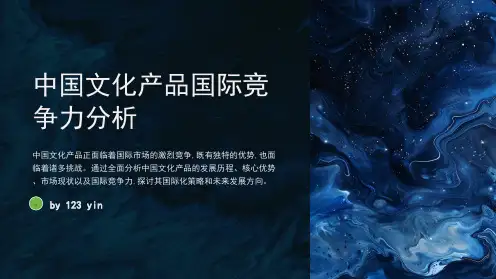
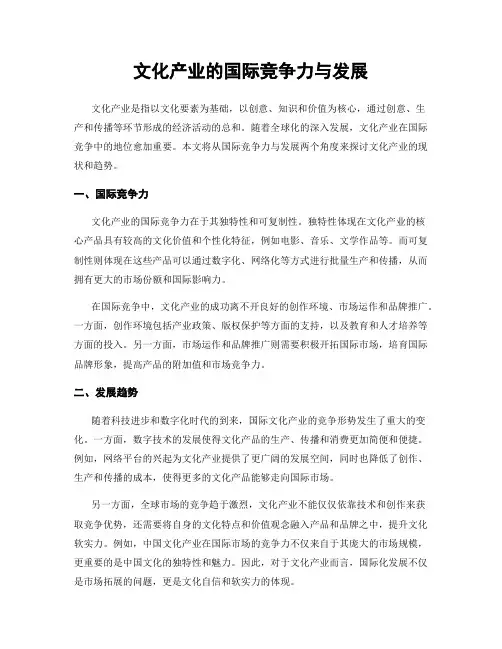
文化产业的国际竞争力与发展文化产业是指以文化要素为基础,以创意、知识和价值为核心,通过创意、生产和传播等环节形成的经济活动的总和。
随着全球化的深入发展,文化产业在国际竞争中的地位愈加重要。
本文将从国际竞争力与发展两个角度来探讨文化产业的现状和趋势。
一、国际竞争力文化产业的国际竞争力在于其独特性和可复制性。
独特性体现在文化产业的核心产品具有较高的文化价值和个性化特征,例如电影、音乐、文学作品等。
而可复制性则体现在这些产品可以通过数字化、网络化等方式进行批量生产和传播,从而拥有更大的市场份额和国际影响力。
在国际竞争中,文化产业的成功离不开良好的创作环境、市场运作和品牌推广。
一方面,创作环境包括产业政策、版权保护等方面的支持,以及教育和人才培养等方面的投入。
另一方面,市场运作和品牌推广则需要积极开拓国际市场,培育国际品牌形象,提高产品的附加值和市场竞争力。
二、发展趋势随着科技进步和数字化时代的到来,国际文化产业的竞争形势发生了重大的变化。
一方面,数字技术的发展使得文化产品的生产、传播和消费更加简便和便捷。
例如,网络平台的兴起为文化产业提供了更广阔的发展空间,同时也降低了创作、生产和传播的成本,使得更多的文化产品能够走向国际市场。
另一方面,全球市场的竞争趋于激烈,文化产业不能仅仅依靠技术和创作来获取竞争优势,还需要将自身的文化特点和价值观念融入产品和品牌之中,提升文化软实力。
例如,中国文化产业在国际市场的竞争力不仅来自于其庞大的市场规模,更重要的是中国文化的独特性和魅力。
因此,对于文化产业而言,国际化发展不仅是市场拓展的问题,更是文化自信和软实力的体现。
在文化产业的国际竞争中,创新是关键。
创新涉及到对文化要素的处理、产品的研发、技术的应用以及商业模式的创新等方面。
例如,Netflix凭借其独特的商业模式和原创内容,成功突破了传统电视行业的壁垒,成为全球最大的流媒体服务提供商之一。
因此,文化产业发展要注重技术和产业融合,拓展新的商业领域和创造新的商业模式,以提高国际竞争力。
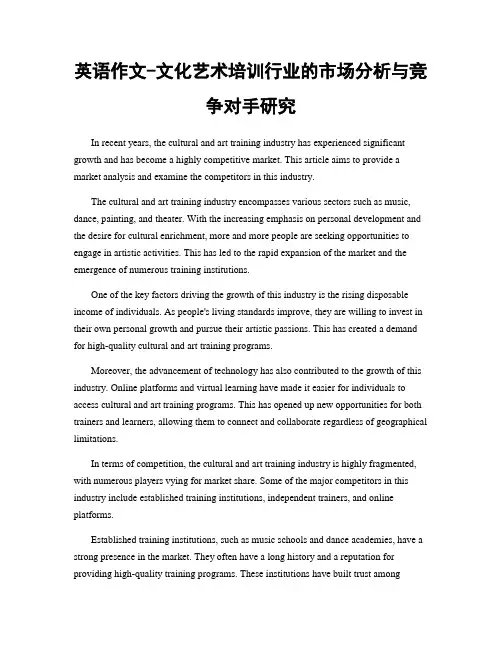
英语作文-文化艺术培训行业的市场分析与竞争对手研究In recent years, the cultural and art training industry has experienced significant growth and has become a highly competitive market. This article aims to provide a market analysis and examine the competitors in this industry.The cultural and art training industry encompasses various sectors such as music, dance, painting, and theater. With the increasing emphasis on personal development and the desire for cultural enrichment, more and more people are seeking opportunities to engage in artistic activities. This has led to the rapid expansion of the market and the emergence of numerous training institutions.One of the key factors driving the growth of this industry is the rising disposable income of individuals. As people's living standards improve, they are willing to invest in their own personal growth and pursue their artistic passions. This has created a demand for high-quality cultural and art training programs.Moreover, the advancement of technology has also contributed to the growth of this industry. Online platforms and virtual learning have made it easier for individuals to access cultural and art training programs. This has opened up new opportunities for both trainers and learners, allowing them to connect and collaborate regardless of geographical limitations.In terms of competition, the cultural and art training industry is highly fragmented, with numerous players vying for market share. Some of the major competitors in this industry include established training institutions, independent trainers, and online platforms.Established training institutions, such as music schools and dance academies, have a strong presence in the market. They often have a long history and a reputation for providing high-quality training programs. These institutions have built trust amongcustomers and have a loyal customer base. However, they may face challenges in adapting to the changing needs and preferences of learners.Independent trainers, on the other hand, offer a more personalized and flexible approach to cultural and art training. They often specialize in specific areas and cater to niche markets. Their advantage lies in their ability to provide individual attention and tailor their programs to meet the unique needs of learners. However, they may lack the resources and infrastructure of established institutions.Online platforms have also emerged as strong competitors in the cultural and art training industry. These platforms offer a wide range of courses and provide convenience and flexibility to learners. They leverage technology to deliver interactive and engaging learning experiences. However, they may face challenges in ensuring the quality of instruction and maintaining a sense of community among learners.To stay competitive in this industry, it is crucial for training institutions to differentiate themselves and offer unique value propositions. This can be achieved through innovative teaching methods, collaborations with renowned artists, or the integration of technology into their programs. Additionally, understanding the evolving needs and preferences of learners and adapting to market trends is essential for success.In conclusion, the cultural and art training industry is a rapidly growing and highly competitive market. Factors such as rising disposable income and technological advancements have fueled its growth. Competitors in this industry include established training institutions, independent trainers, and online platforms. To succeed in this market, it is important to differentiate oneself and stay attuned to the changing needs of learners.。
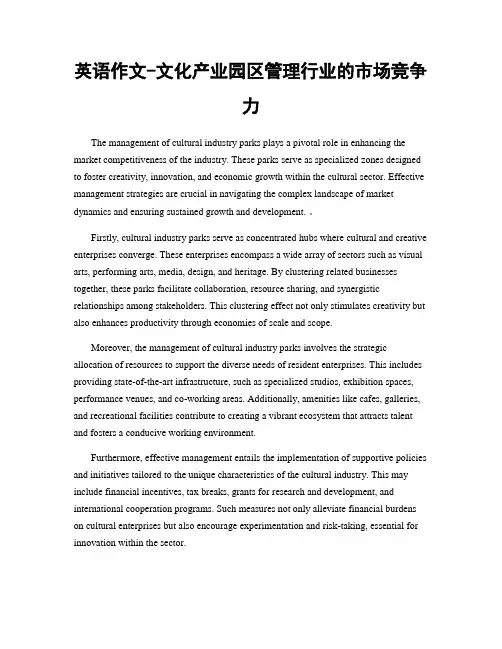
英语作文-文化产业园区管理行业的市场竞争力The management of cultural industry parks plays a pivotal role in enhancing the market competitiveness of the industry. These parks serve as specialized zones designed to foster creativity, innovation, and economic growth within the cultural sector. Effective management strategies are crucial in navigating the complex landscape of market dynamics and ensuring sustained growth and development. 。
Firstly, cultural industry parks serve as concentrated hubs where cultural and creative enterprises converge. These enterprises encompass a wide array of sectors such as visual arts, performing arts, media, design, and heritage. By clustering related businesses together, these parks facilitate collaboration, resource sharing, and synergistic relationships among stakeholders. This clustering effect not only stimulates creativity but also enhances productivity through economies of scale and scope.Moreover, the management of cultural industry parks involves the strategic allocation of resources to support the diverse needs of resident enterprises. This includes providing state-of-the-art infrastructure, such as specialized studios, exhibition spaces, performance venues, and co-working areas. Additionally, amenities like cafes, galleries, and recreational facilities contribute to creating a vibrant ecosystem that attracts talent and fosters a conducive working environment.Furthermore, effective management entails the implementation of supportive policies and initiatives tailored to the unique characteristics of the cultural industry. This may include financial incentives, tax breaks, grants for research and development, and international cooperation programs. Such measures not only alleviate financial burdens on cultural enterprises but also encourage experimentation and risk-taking, essential for innovation within the sector.In addition to infrastructure and policies, successful management of cultural industry parks requires proactive engagement with stakeholders. This involves building strong partnerships with educational institutions, research centers, industry associations, and government agencies. Collaborative efforts can lead to the development of specialized training programs, knowledge sharing platforms, and joint research projects, thereby nurturing talent and driving industry innovation.Moreover, the global market competitiveness of cultural industry parks hinges on their ability to adapt to technological advancements and digital transformation. Embracing digitalization strategies, such as virtual exhibitions, online platforms for content distribution, and digital marketing campaigns, can expand market reach and audience engagement. Integration of cutting-edge technologies like augmented reality (AR), virtual reality (VR), and artificial intelligence (AI) into creative processes further enhances product offerings and consumer experiences.Additionally, effective management necessitates a keen understanding of market trends and consumer preferences both domestically and internationally. Market research and analysis enable cultural industry parks to identify emerging opportunities, anticipate demand shifts, and tailor offerings accordingly. This market-oriented approach ensures relevance and competitiveness in a rapidly evolving global landscape.Furthermore, sustainability and environmental consciousness are increasingly integral to the management of cultural industry parks. Adopting green technologies, reducing carbon footprints, and promoting eco-friendly practices not only align with global sustainability goals but also enhance corporate social responsibility (CSR) efforts. Sustainable practices contribute to brand reputation, appeal to environmentally conscious consumers, and attract investments from socially responsible investors.In conclusion, the market competitiveness of cultural industry parks hinges on effective management strategies that foster creativity, innovation, collaboration, and sustainability. By providing robust infrastructure, supportive policies, technological integration, stakeholder engagement, and market-oriented approaches, these parks can thrive in an increasingly competitive global marketplace. As catalysts for cultural andeconomic development, well-managed cultural industry parks are poised to shape the future of the cultural sector, driving growth and prosperity for stakeholders and communities alike.。
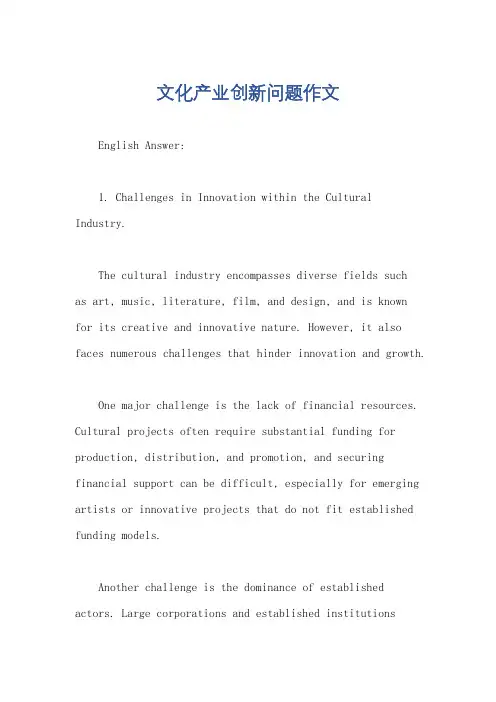
文化产业创新问题作文English Answer:1. Challenges in Innovation within the Cultural Industry.The cultural industry encompasses diverse fields suchas art, music, literature, film, and design, and is knownfor its creative and innovative nature. However, it also faces numerous challenges that hinder innovation and growth.One major challenge is the lack of financial resources. Cultural projects often require substantial funding for production, distribution, and promotion, and securing financial support can be difficult, especially for emerging artists or innovative projects that do not fit established funding models.Another challenge is the dominance of established actors. Large corporations and established institutionsoften control distribution channels and marketing platforms, making it difficult for new and innovative ideas to break through. This can lead to homogenization and a lack of diversity in cultural offerings.Furthermore, the cultural industry is increasingly fragmented, with niche audiences and customized content preferences. This makes it challenging for creators and producers to reach a wide audience and generate significant revenue.Finally, the cultural industry is subject to rapid technological changes. New technologies, such as streaming platforms and social media, are transforming the waycultural content is produced, distributed, and consumed. Creators and producers need to adapt quickly to these changes to stay relevant and competitive.2. Strategies for Fostering Innovation in the Cultural Industry.To overcome these challenges and foster innovationwithin the cultural industry, several strategies can be adopted:Encourage Partnerships and Collaborations: Cross-sector collaborations between cultural institutions, businesses, and non-profits can provide new perspectives, resources, and distribution channels for innovative projects.Support Emerging Artists and Projects: Funding, mentorship programs, and incubation spaces can empower emerging artists and support experimental or unconventional ideas that challenge traditional norms.Create Open and Equitable Platforms: Governments and industry organizations can develop platforms and policies that provide equal opportunities for creators and producers to showcase their work and reach diverse audiences.Embrace Technological Innovation: Cultural institutions and creators need to embrace new technologies to enhance creativity, расширить охват and engage with audiences in innovative and interactive ways.Foster a Culture of Risk-Taking: A supportive environment that encourages experimentation and risk-taking is crucial for fostering innovation and challenging the status quo.By implementing these strategies, the cultural industry can overcome challenges, unleash its innovative potential, and continue to contribute to the vibrancy and diversity of society.Chinese Answer:文化产业创新问题。
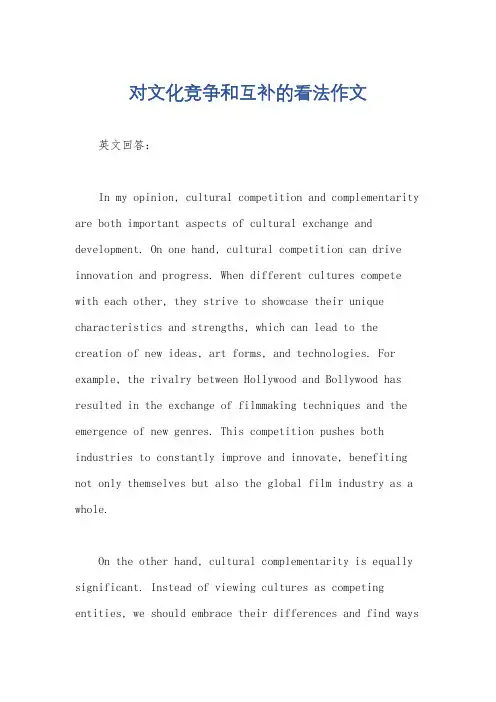
对文化竞争和互补的看法作文英文回答:In my opinion, cultural competition and complementarity are both important aspects of cultural exchange and development. On one hand, cultural competition can drive innovation and progress. When different cultures compete with each other, they strive to showcase their unique characteristics and strengths, which can lead to the creation of new ideas, art forms, and technologies. For example, the rivalry between Hollywood and Bollywood has resulted in the exchange of filmmaking techniques and the emergence of new genres. This competition pushes both industries to constantly improve and innovate, benefiting not only themselves but also the global film industry as a whole.On the other hand, cultural complementarity is equally significant. Instead of viewing cultures as competing entities, we should embrace their differences and find waysto complement each other. Cultural complementarity allowsfor the exchange of knowledge, traditions, and values, fostering a deeper understanding and appreciation ofdifferent cultures. For instance, the fusion of Chinese and Western cuisines in the creation of dishes like sweet and sour chicken or fortune cookies demonstrates how cultural complementarity can lead to the development of unique and delicious food experiences that appeal to people from different backgrounds.中文回答:在我看来,文化竞争和互补都是文化交流和发展的重要方面。
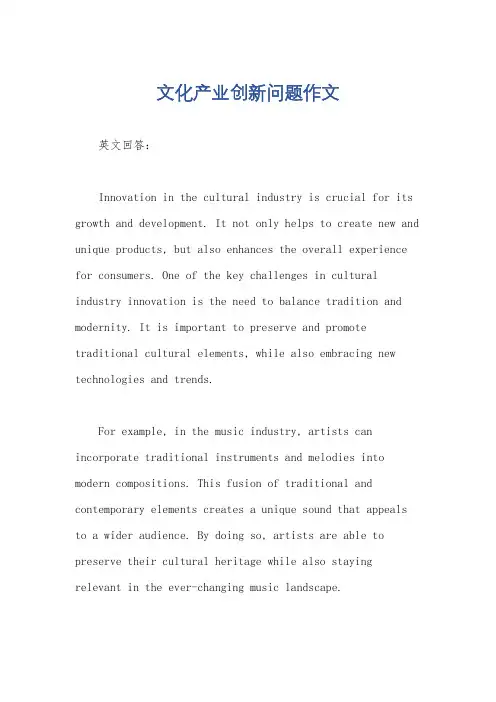
文化产业创新问题作文英文回答:Innovation in the cultural industry is crucial for its growth and development. It not only helps to create new and unique products, but also enhances the overall experience for consumers. One of the key challenges in cultural industry innovation is the need to balance tradition and modernity. It is important to preserve and promote traditional cultural elements, while also embracing new technologies and trends.For example, in the music industry, artists can incorporate traditional instruments and melodies into modern compositions. This fusion of traditional and contemporary elements creates a unique sound that appeals to a wider audience. By doing so, artists are able to preserve their cultural heritage while also staying relevant in the ever-changing music landscape.Another challenge in cultural industry innovation is the need to cater to diverse consumer preferences. With globalization, cultural products are consumed by people from different backgrounds and cultures. Therefore, it is important for cultural industry practitioners to understand and adapt to these diverse preferences in order to create products that resonate with a global audience.For instance, in the film industry, filmmakers can explore different storytelling techniques that appeal to a wide range of cultural backgrounds. This could involve incorporating elements of different cultures, or telling stories that are relatable to people from various parts of the world. By doing so, filmmakers are able to create films that have a universal appeal and can be enjoyed by audiences from different cultural backgrounds.Furthermore, another challenge in cultural industry innovation is the need to embrace digitalization. With the rise of the internet and digital platforms, traditional cultural industries such as publishing and broadcasting have had to adapt to new ways of creating and distributingcontent. This has led to the emergence of new business models and opportunities.For example, in the publishing industry, authors canself-publish their books digitally, reaching a wider audience without the need for traditional publishing houses. This not only allows authors to have more control overtheir work, but also opens up opportunities for new and undiscovered talent to enter the industry. Similarly, inthe broadcasting industry, streaming platforms have become increasingly popular, allowing consumers to access a wide range of cultural content anytime and anywhere.In conclusion, innovation in the cultural industry is essential for its growth and success. By balancingtradition and modernity, catering to diverse consumer preferences, and embracing digitalization, culturalindustry practitioners can create unique and engaging products that appeal to a global audience. Through innovation, the cultural industry can continue to thriveand contribute to the enrichment of society.中文回答:文化产业创新对于其增长和发展至关重要。
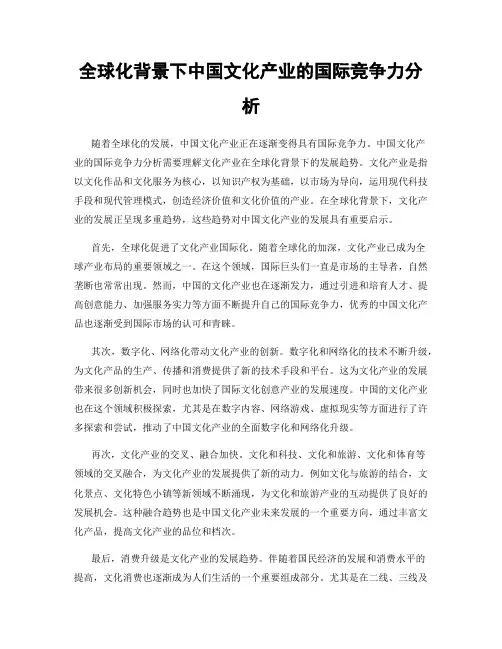
全球化背景下中国文化产业的国际竞争力分析随着全球化的发展,中国文化产业正在逐渐变得具有国际竞争力。
中国文化产业的国际竞争力分析需要理解文化产业在全球化背景下的发展趋势。
文化产业是指以文化作品和文化服务为核心,以知识产权为基础,以市场为导向,运用现代科技手段和现代管理模式,创造经济价值和文化价值的产业。
在全球化背景下,文化产业的发展正呈现多重趋势,这些趋势对中国文化产业的发展具有重要启示。
首先,全球化促进了文化产业国际化。
随着全球化的加深,文化产业已成为全球产业布局的重要领域之一。
在这个领域,国际巨头们一直是市场的主导者,自然垄断也常常出现。
然而,中国的文化产业也在逐渐发力,通过引进和培育人才、提高创意能力、加强服务实力等方面不断提升自己的国际竞争力,优秀的中国文化产品也逐渐受到国际市场的认可和青睐。
其次,数字化、网络化带动文化产业的创新。
数字化和网络化的技术不断升级,为文化产品的生产、传播和消费提供了新的技术手段和平台。
这为文化产业的发展带来很多创新机会,同时也加快了国际文化创意产业的发展速度。
中国的文化产业也在这个领域积极探索,尤其是在数字内容、网络游戏、虚拟现实等方面进行了许多探索和尝试,推动了中国文化产业的全面数字化和网络化升级。
再次,文化产业的交叉、融合加快。
文化和科技、文化和旅游、文化和体育等领域的交叉融合,为文化产业的发展提供了新的动力。
例如文化与旅游的结合,文化景点、文化特色小镇等新领域不断涌现,为文化和旅游产业的互动提供了良好的发展机会。
这种融合趋势也是中国文化产业未来发展的一个重要方向,通过丰富文化产品,提高文化产业的品位和档次。
最后,消费升级是文化产业的发展趋势。
伴随着国民经济的发展和消费水平的提高,文化消费也逐渐成为人们生活的一个重要组成部分。
尤其是在二线、三线及以下城市,文化消费的潜力十分巨大,这也为中国文化产业的发展提供了广阔的市场。
在这个方面,中国文化产业需要加强自身的实力,提供符合消费者需求的高质量文化产品,进一步促进国内文化消费的升级,实现更快的发展。
英语作文-文化产业园区管理行业的市场竞争策略In the competitive the rapidly evolving landscape of cultural industry parks, competition strategies play a pivotal role in determining the success of these zones. As cultural industry parks continue to develop, their management must navigate a complex environment characterized by dynamic market demands, technological advancements, and diverse stakeholder interests. Effective competition strategies are essential for attracting investments, fostering innovation, and sustaining long-term growth.One of the primary strategies for gaining a competitive edge in this sector is the enhancement of infrastructure and facilities. Cultural industry parks must provide state-of-the-art amenities, including versatile exhibition spaces, advanced digital technology, and supportive business services. These elements not only attract high-quality tenants but also create an environment conducive to creativity and innovation. Investing in infrastructure ensures that the park can support a wide range of cultural activities, from art exhibitions and film screenings to tech-driven creative projects, thereby enhancing its appeal to a broader audience.Furthermore, fostering a vibrant community of creators and entrepreneurs is crucial. This can be achieved through the establishment of incubators, workshops, and networking events that encourage collaboration and knowledge sharing. By creating a supportive ecosystem, cultural industry parks can nurture talent and stimulate the development of new ideas and projects. This approach not only enhances the park's cultural vibrancy but also boosts its reputation as a hub for creativity and innovation. Programs designed to mentor startups and provide them with resources and exposure are instrumental in building a strong community of artists, designers, and tech innovators.In addition to infrastructure and community building, strategic marketing and branding are vital components of a successful competition strategy. Cultural industry parks must develop a unique brand identity that highlights their distinctive features andcultural value. This involves crafting compelling narratives that resonate with target audiences, whether they are local visitors, international investors, or creative professionals. Effective marketing campaigns that leverage digital media, social networks, and cultural festivals can significantly enhance the park’s visibility and attractiveness. By promoting the park’s unique offerings and success stories, management can establish a strong brand presence in both local and global markets.Collaboration with educational institutions and research organizations is another strategic move that can enhance the competitive edge of cultural industry parks. Partnerships with universities, research institutes, and cultural organizations can facilitate access to cutting-edge research, new technologies, and innovative practices. These collaborations can also lead to the development of specialized training programs, workshops, and symposiums that keep the workforce skilled and up-to-date with the latest trends in the cultural and creative industries. By integrating academic and practical knowledge, cultural industry parks can enhance their innovation capabilities and ensure a steady influx of fresh ideas and talent.Moreover, adopting sustainable and green practices is becoming increasingly important in the management of cultural industry parks. Sustainability not only meets the growing global demand for environmentally responsible practices but also enhances the park’s appeal to eco-conscious investors and visitors. Initiatives such as energy-efficient buildings, waste reduction programs, and green public spaces can significantly boost the park's image and operational efficiency. Emphasizing sustainability aligns with global trends and helps attract funding and partnerships from organizations committed to environmental responsibility.Lastly, cultivating a strong network of local, national, and international partnerships is essential for the long-term success of cultural industry parks. Engaging with government bodies, cultural organizations, and international cultural networks can open up opportunities for collaboration, funding, and market expansion. These partnerships can enhance the park’s resources, create new business opportunities, and foster greater cultural exchange and understanding. By building a robust network, cultural industryparks can position themselves as key players in the global cultural economy, driving innovation and cultural development on a broader scale.In conclusion, the competition strategies for cultural industry parks must be multifaceted, encompassing infrastructure development, community building, strategic marketing, educational collaboration, sustainability, and networking. By implementing these strategies effectively, cultural industry parks can enhance their competitiveness, attract diverse stakeholders, and ensure sustainable growth and innovation in the cultural and creative sectors.。
竞争文化作文英语模板英文回答:Competition culture is a prevalent phenomenon in modern society, where individuals and organizations strive to outperform others to achieve success and recognition. While competition can foster innovation and drive progress, it can also have negative consequences on individuals and communities.One of the potential benefits of competition is that it can motivate people to push their limits and reach their full potential. The desire to succeed can drive individuals to acquire new skills, work harder, and innovate. Competition can also create a sense of purpose and meaning, as individuals strive to make a mark on the world and leave a legacy.Furthermore, competition can foster innovation and progress. When individuals and organizations compete, theyare constantly trying to find new and better ways to achieve their goals. This can lead to the development of new products, services, and technologies that benefit society as a whole.However, competition culture can also have negative consequences. One potential downside is that it can lead to excessive stress and anxiety. Individuals who are constantly competing with others may feel overwhelmed and anxious about not meeting expectations. This can lead to burnout, health problems, and even mental health issues.Another concern is that competition can create a sense of inequality and division. When individuals and groups are constantly competing for resources and recognition, it can lead to resentment, envy, and social conflict. This can undermine social cohesion and create a sense of alienation and isolation.Moreover, competition culture can stifle creativity and diversity. In a competitive environment, individuals may be more likely to conform to expectations and avoid takingrisks. This can lead to a lack of originality and a stifled creativity.中文回答:竞争文化是现代社会中普遍存在的现象,个人和组织都力求超越他人以取得成功和认可。
英语作文-文化产业园区管理行业的国际合作机会与挑战In today's globalized economy, the management of cultural industry parks presents both opportunities and challenges for international cooperation. These parks serve as hubs where cultural creativity and economic development converge, offering a fertile ground for collaborative ventures on a global scale.Firstly, international cooperation in cultural industry park management fosters cross-cultural exchange. By partnering with overseas entities, these parks can enrich their cultural offerings, diversify their creative inputs, and attract a broader audience. This synergy not only enhances the appeal of the park but also strengthens cultural diplomacy and understanding between nations.Moreover, such collaborations often bring about technological advancements and innovation. International partners can contribute diverse technological know-how and managerial expertise, thereby upgrading infrastructure, implementing sustainable practices, and improving operational efficiency within the park. These advancements not only benefit the park itself but also spill over into the broader economy, stimulating growth and competitiveness.Furthermore, globalization enables cultural industry parks to tap into international markets more effectively. Through strategic partnerships and alliances, parks can expand their reach, export cultural products and services, and attract foreign investments. This internationalization not only boosts revenue streams but also elevates the park's profile as a global cultural hub, enhancing its influence and prestige on the world stage.However, alongside these opportunities, managing international cooperation in cultural industry parks poses several challenges. One of the foremost challenges is navigating cultural differences and local regulations. Cultural norms, business practices, and legal frameworks vary widely across countries, necessitating careful negotiation and adaptation strategies to ensure smooth collaboration and compliance with local laws.Moreover, financial and economic disparities between partnering nations can pose significant hurdles. Discrepancies in funding, investment capabilities, and economic stability may affect the feasibility and sustainability of joint projects. Mitigating financial risks and ensuring equitable benefit-sharing are crucial considerations for successful international cooperation in cultural industry park management.Additionally, geopolitical factors and international relations dynamics can impact collaborative efforts. Shifts in diplomatic relations, trade policies, or geopolitical tensions may disrupt ongoing partnerships or deter potential collaborations. Navigating these external factors requires diplomatic finesse, foresight, and contingency planning to safeguard long-term cooperation and project viability.In conclusion, while international cooperation presents abundant opportunities for cultural industry park management, it also demands careful navigation of challenges inherent in cross-border partnerships. By leveraging cultural diversity, technological synergies, and market opportunities, these parks can thrive as vibrant centers of creativity and economic vitality on the global stage. Effective management strategies that address cultural, financial, and geopolitical complexities are essential to harnessing the full potential of international cooperation in advancing cultural industry parks worldwide.。
英语作文-文化艺术培训行业的国际化发展战略与机遇The internationalization of the cultural and arts training industry represents a strategic opportunity for growth and development in the global arena. As societies become increasingly interconnected through technology and globalization, the arts have emerged as a pivotal area for cross-cultural exchange and economic advancement. This article explores the dynamics, strategies, and opportunities inherent in the international expansion of the cultural and arts training sector.Cultural and arts training encompasses a wide array of disciplines, including visual arts, performing arts, music, dance, and more. These fields not only preserve and promote cultural heritage but also foster creativity, innovation, and personal development among individuals worldwide. The internationalization of this sector is driven by several key factors, each contributing to its significance on a global scale.Firstly, cultural diplomacy plays a crucial role in international relations. Arts and cultural exchanges serve as bridges between nations, fostering mutual understanding and cooperation. Educational institutions and training centers that offer programs in cultural and arts education contribute significantly to this diplomatic effort by nurturing a global citizenry that appreciates and respects diverse cultural expressions.Secondly, economic opportunities abound in the international arts training sector. As demand for cultural and arts education grows globally, so does the market for qualified instructors, curriculum developers, and educational materials. Institutions and organizations that position themselves as leaders in this field can capitalize on these opportunities by expanding their reach beyond national borders and establishing partnerships with international counterparts.Moreover, technological advancements have revolutionized the way cultural and arts training is delivered and accessed worldwide. Online platforms, virtual classrooms, and digital resources have democratized access to education, allowing students from remoteareas to participate in high-quality arts training programs previously inaccessible to them. This digital transformation not only enhances the scalability of arts education but also facilitates cross-cultural collaboration among students and educators across different continents.Strategically, institutions seeking to internationalize their cultural and arts training programs must adopt a multifaceted approach. This includes:1. Curriculum Localization: Adapting curriculum content to reflect cultural nuances and preferences of target regions while maintaining educational integrity and standards.2. Partnership Development: Establishing collaborations with foreign universities, cultural organizations, and governmental bodies to facilitate student exchanges, joint research initiatives, and shared educational programs.3. Market Research and Adaptation: Conducting thorough market research to identify demand trends, preferences, and competitive landscapes in target international markets. Tailoring marketing strategies and program offerings accordingly ensures relevance and attractiveness to prospective students.4. Technology Integration: Leveraging digital platforms and online tools to deliver immersive and interactive arts education experiences globally. Investing in state-of-the-art technology enhances educational outcomes and student engagement across borders.5. Cultural Sensitivity: Promoting cultural sensitivity and diversity within educational environments to foster a welcoming and inclusive atmosphere for students from diverse backgrounds.In conclusion, the internationalization of the cultural and arts training industry presents significant strategic opportunities for educational institutions and organizations worldwide. By embracing cultural diplomacy, leveraging economic opportunities, harnessing technological advancements, and adopting a strategic approach to internationalization, stakeholders in this sector can position themselves at the forefront ofglobal arts education. This not only enriches individual lives but also contributes to the broader goal of fostering international understanding and cooperation through cultural exchange and education.。
英语作文-文化艺术培训行业的市场调研与竞争对策In recent years, the cultural and arts training industry has seen a significant surge in interest as individuals seek to enrich their lives with creative skills and hobbies. This industry encompasses a wide range of activities, from music and dance to painting and sculpture, providing a creative outlet for people of all ages. The market research for this sector indicates a growing trend, particularly in urban areas where disposable income and the pursuit of leisure activities are on the rise.The competitive landscape of the cultural and arts training industry is diverse, with numerous small and medium-sized enterprises (SMEs) dominating the scene. These entities often specialize in specific art forms, offering personalized and in-depth training. However, the rise of online platforms has introduced a new dimension to the competition, enabling access to a global audience and a wealth of resources that were previously unavailable.To remain competitive, businesses in this industry must adopt a multifaceted approach. One key strategy is to differentiate their offerings. This can be achieved by developing unique curriculums that blend traditional techniques with contemporary styles, thereby catering to a broader demographic. Additionally, forming partnerships with local art galleries and cultural centers can provide students with opportunities to showcase their work, adding value to the educational experience.Another critical aspect is the adoption of technology. Online classes and virtual workshops have become increasingly popular, especially in the wake of the global pandemic. By integrating digital tools and platforms, businesses can expand their reach and provide flexible learning options for students. This not only includes live-streamed sessions but also on-demand content that allows for self-paced learning.Marketing plays a pivotal role in attracting and retaining students. Effective use of social media to highlight student success stories, engaging content that showcases the joyof learning, and targeted advertising campaigns can help in building a strong brand presence. Moreover, leveraging customer feedback to improve services and tailoring offerings to meet the specific needs of the community can lead to higher satisfaction rates and word-of-mouth referrals.Financial sustainability is another area that requires attention. While it's essential to invest in quality instructors and materials, it's equally important to have a sound business model. Offering tiered pricing structures, discounts for long-term commitments, and bundling courses can make the services more accessible while ensuring profitability.In conclusion, the cultural and arts training industry is ripe with opportunities for those willing to innovate and adapt. By focusing on differentiation, technological integration, strategic marketing, and financial sustainability, businesses can not only survive but thrive in this competitive environment. The key is to understand the market dynamics, listen to customer needs, and continuously strive for excellence in both the art forms taught and the educational experience provided. With passion and perseverance, the cultural and arts training industry can continue to flourish, enriching lives and communities with the beauty of artistic expression.。
中国文化产业发展与国际竞争力研究随着中国经济的发展和国际影响力的增强,中国文化产业也在快速成长。
从文化产业总量、贡献率、国际化程度等方面来看,中国文化产业的竞争力不断提升。
本文将探讨中国文化产业发展的现状、存在的问题以及提高国际竞争力的途径。
一、文化产业总量高速增长文化产业是指以文化为基础,以文化产品创造为核心的产业,包括出版、广播电视、电影、音像制品、文艺创作与表演、文化批发与零售等领域。
近年来,中国文化产业的总规模不断扩大,从2005年的1.32万亿元增长到2019年的5.96万亿元,年均增速达到13.9%。
其中,影视产业和数字文化产业增速最快。
中国电影市场在近十年内呈现爆发式增长,2019年全年观众人次达到6.42亿,票房收入达到64.26亿元。
而数字文化产业以互联网、手机、电子商务等为代表,成为推动中国文化产业快速发展的主要驱动力。
二、文化产业贡献率不断提高随着文化产业规模的增长,其对中国经济的贡献率也不断提高。
2019年,中国文化产业增加值占国内生产总值的4.57%。
在城市层面,文化产业已成为推动城市经济发展的重要支柱产业之一,不仅提供了大量的就业机会,还带动了相关产业的发展。
三、文化产业国际化进程加快随着中国文化产业的发展,其国际化进程也在加速。
近年来,中国影视作品在国际市场上的表现越来越出色,如《流浪地球》《战狼2》等影片在全球市场取得了不俗的票房成绩。
此外,中国美术、书法、音乐等传统文化也在国际市场上吸引了越来越多的关注。
然而,中国文化产业在国际市场上还存在一些问题。
首先是文化产品的国际化水准需要提高,这需要大量的资金投入、人才培养和原创力量的不断积累。
其次,文化产业的供给侧结构性改革仍需深耕细作。
当前,我国文化产业还存在着创新不足、产业结构不健全、版权保护等问题,需要通过改革来深化市场化、利用好互联网等新技术驱动力来推动文化产业提质增效。
四、提高文化产业国际竞争力的途径在提高文化产业国际竞争力方面,需要从以下几个方面入手:1.加强产业布局规划,优化文化产品供给结构,促进新业态发展和转型升级。
我国文化产业国际竞争力研究摘要:文化自古至今都是中外交流的重要桥梁,文化在对外贸易中起着非常重要的的作用。
20 世纪90 年代以来我国文化贸易处于萌芽阶段,其发展水平与发达国家差距很大。
近几年来,我国开始在各方面支持发展文化产业,以不断缩小与发达国家之间的差距。
本文分析了我国文化贸易的发展现状和问题并采用指标评价方法与实证分析中国文化贸易国际竞争力,用SWOT分析法分析影响我国文化贸易竞争力水平的因素,最后从三个方面给出了相关的政策建议。
关键词:文化贸易;国际竞争力;政策建议;文化产业Study on international competitiveness of China's cultural industryAbstractCulture is a bridge for Sino-foreign exchanges since ancient times, and plays a very important role in foreign trade.Cultural trade in China in the 1990 of the 20th cen tury in its infancy stage, it has a large development gap with the developed countries.In rec ent years,China supports the development of cultural industry in all aspects, so as to narro w the gap between developed and This paper analyses the present condition and problem of cultural trade development and adopted evaluation method and empirical analysis of inter national competitiveness of Chinese culture,trade,using SWOT analysis to analyze factors t hat affect the competitiveness level of China's cultural trade, finally given from three aspect s: policy recommendations.Key words:Cultural trade; International competitiveness; Policy recommend; cultural indu stryAcknowledgementsFirst and foremost, I would like to express my heartfelt gratitude to my supervisor, Mr. Wang Hai Yuan, for his instructive advice and useful suggestions on my thesis,and for his constant encouragement and guidance. he has walked me through all the stages of the writing of this thesis.I am deeply grateful of his help in the completion of this thesis,without his consistent and illuminating instruction, this thesis could not have reached its present form.Second, I am also deeply indebted to all the other tutors and teachers in Business English studies for their direct and indirect help to me. I also owe my sincere gratitude to my friends and my fellow classmates who gave me their help and time in listening to me and helping me work out my problems during the difficult course of the thesis.Last my thanks would go to my beloved family for their loving considerations and great confidence in me all through these years.Contents中文摘要 (i)Abstract (ii)Aknowledgements (iii)Introduction (1)I. Present situation of cultural trade research in China and abroad (2)A. Research status of foreign scholars (2)B. Research status of domestic scholars (2)II.The strategic significance of cultural trade on international competitiveness (3)A. Power of cultural trade development is the only option (3)B. Help to enhance the international image and impact (4)C.Improve the structure of import and export commoditie s (4)D.Promoting sustainable development of cultural trade (5)III. Trade development present situation analysis and characteristics of Chinese culture (5)A.Analysis of the present situation of cultural trades (5)B.Characteristics of culture and trade in China (7)Ⅳ.SWOT analysis of China foreign trade and cultural development (7)A.S-The main advantages of China international cultural trade development (7)B.W- The disadvantage of China's foreign trade and cultural development (7)C.O-The opportunities of China's foreign trade and cultural development (8)D.T-The threats of China's foreign trade and cultural development (8)Ⅴ. China cultural trade development policy proposals (8)A. Government policy proposals (9)B.Cultural industries policy recommendations (10)C.Enterprise level policy recommendations (12)Conclusion (13)Notes (14)Bibliography (15)Study on international competitiveness of China's cultural industryIntroductionDue to our culture has a long history, a wealth of resources for cultural p rovides very good conditions for the development of trade.But at the same time, we a re seeing some of the developed countries by using technology, developed econom y, and improve the institutional and other aspects of a company's advantage, produci ng highly competitive exports of cultural products, dominates the international marke t position.Currently most of the deficit in the trade of Chinese culture,competitiven ess is not strong, facing the pressure of international competition are not optimistic. Against this background, studying the trade competitiveness of Chinese culture is ver y important. Economic aspects of culture have a special competitive advantage, it is a ble to keep pace with, follow the changes of the times and changes, able to withstan d the test of time.In the deepening economic globalization today, cultural innovation a nd change at the same time, cultural innovation and reforms have created new space s, and other aspects of economic strategy has no such ability. Economy and culture e mbodies a "total effect", it is not only an economic function,and is the home of econo my, an economic structure.Cultural economic development can bring such as sports, arts, the media, and even political developments. Cultural economy can also play a role in promotin g employment,guarantee the stability of the State and society, national image enhance ment functions. Because of the culture and identity of intimacy and other reasons, c ultural trade easier to form "Radiation effects", other industries will follow the cultur al and economic development, and even has the potential to become an important ma gic weapon of the trade negotiations.I. Present situation of cultural trade research in China and abroad A.Research status of foreign scholarsBy Porter founded the international competitiveness of the country, "dia mond model" focused, demand, production and related industries and the four basic elements of the strategy of the enterprise is the largest and most direct impact on ind ustrial competitiveness factors, starting point of national competitive advantage and t here is industry competitive advantage. The"diamond model" has introduced new anal ysis chart and analysis method is a break through, is conducting a competitiveness st udy of the most complete theory. “Many scholars in the research process, the "diamo nd model" proposed revision and improvement. Dunning (1993) said that the role o f transnational corporations in the global economy is strong.”1“Cho (1994) pointed out that the "diamond model" can be more reasona ble to explain the international competitiveness of industry in the developed worl d, based on an extensive analysis of the points raised.”2 But for developing countrie s or least developed countries on the interpretation of the international competitivene ss of the industry, the "diamond model"proposed "nine-factor model".B. Research status of domestic scholarsMost Chinese scholars by comparing the overseas cultural industry theor y of international competition, international cultural trade competitiveness analysis t he economic analysis model with "diamond model", as well as improve the contras t with China's actual situation, to study the cultural industries internationally competi tive:Theory on international competitiveness of China's two main aspects of the study is the analysis of constructing the index system of industrial international competitiveness and international competitiveness of a specific industry. Pei Changhong international competitiveness indicators representative of the industry are mainly two kinds, namely to show the index (leading to competition) and analysis (competitive performance results) two, this is the first time Chinese scholars proposed for evaluation of the industrial competitiveness of more rational and systematic evaluation indexes system.3II.The strategic significance of cultural trade on internationalcompetitivenessA.Power of cultural trade development is the only option.To scientific and technological progress and innovation as primary catal yst of economic development of the whole society, as the premier strategy enhanc e independent innovation ability is the core of building an innovation-oriented coun try. At present, our country is a true manufacturing power, domestic resources and e nvironmental deterioration in contradiction with 's status as the world's factory. Beca use of the technological content of products is too low, little or no creative design, h igh brand recognition reasons, affect China's overall export trade. “China's economi c development in the future will be more dependent on knowledge innovation, rathe r than investment, cost of depleting resources for competitive advantage.”4 Creativit y and cultural industries talents agglomeration effects, does not take up too much lan d and resources, is a knowledge-intensive industry, not resource-intensive industrie s, has a low input and high returns and so on.Cultural products and general product c omparison, profits are terrifying.Vigorously promote cultural products "go", you can increase the added value of China's export products, is our country by trading pow er to trade powers, the only choice.B. Help to enhance the international image and impactCultural products are not only commodities, economic attributes, and pr operties of the spirit, ideology, about the role of the brand image of a country abroa d should not be underestimated. It can reflect this country 's level of technological d evelopment, expanding its cultural influence and radiation, and to improve their inter national competitiveness. “Now all countries play the culture card through cultural in fluence expanding its brand awareness, but also is an important carrier to showcase t heir cultu ral image.”5 For instance United States culture and the rapid expansion of t he market share of world culture, brought its huge trading revenue at the same tim e, United States hegemony and cultural values to the world. Chinese culture is broad and profound, is our marketing innovative products, a solid foundation in the intern ational arena, China's outstanding cultural and creative products, "going out", for th e dissemination of Chinese culture,establish new image of extraordinary.C. Improve the structure of import and export commoditiesOn trade in goods in China have a certain competitiveness, many product s of export share in the international market accounts for a large proportion.Howeve r, seen from the trade structure, we still lag behind on the service,which is a major fact or in the trade imbalance in China. As a special cultural trade, trade in services has b ecome part of international trade.Cultural trade as part of the tertiary sector, with goo d potential for development. Therefore, the development of the cultural exports, will promote the new development of China's service industry, or you can promote the im provement of China's export structure and.D.Promoting sustainable development of cultural tradeAll along, the quantitative growth and trade processing-oriented manne r is an important measure to enhance competitiveness, however, from the point of vie w of sustainable development, is not a reasonable approach. Therefore,transforming t he mode of foreign trade growth, improve value-added products has become a top pr iority. “Cultural industries with high added value in line with the direction of econo mic development of our country, its great attraction not only in terms of direct econ omic benefits, also has a strong industrial implication and ripple effects. ”6 Such as t he one this big long not only led to hits thermal, greatly promoting Korea earn foreig n exchange through the export of cultural products has brought about direct economi c benefits, but also led the Korea travel, beauty, food, clothing, cosmetics and other i ndustrial development, and make more and more people in Korea favor. Thus, prom oting cultural exports, the sustainable development is not only conducive to trade, a s well as other related industry products exports.III. Trade development present situation analysis andcharacteristics of Chinese cultureA.Analysis of the present situation of cultural tradeTrade overall is good, cultural trade weak.“Since 2001 after joining th e WTO, China's foreign trade rapid growth in overall, an increase of about 20%. Bu t we couldn't cheer on cultural trade.”7 Anecdotal data and statistics from the differen t culture media, it is not difficult to see the cultural development of the trade imbalan ce is a real problem facing China's cultural trade, there is a huge deficit. From the overall perspective, cultural trade volume is increasing, but trade volume ratio has no t improved significantly, lack of cultural trade development:No brand of cultural products and services in the world based on the main stream market. Neither United States-style blockbusters nor will lead Asia's"Korean wave", which does not match with China's 5,000 years of civilization.Cultural trade product structure is unreasonable.Unreasonable product structure is another phenomenon in cultural trade,cultural trade tools and the physical carrier of culture is the culture in hardware, such as film, cameras, video recorders, video cameras, etc. Their trade volume accounted for morethan half of China's total foreign trade, is the second-largest exporter. 8But its trade is equal to goods trade, less profit, advantage human capital in our country if it is not obvious,restricted their exports high. Culture is a major component of cultural software, such as films, books, games, theatrical performances, and so on.It has both commercial property and art, will bring in an extra super high profits. 9For example the popularity of Korean dramas of Korea brings the hug e revenues from trade, bringing not only film and television income at the same ti me promote the development of industries associated with the film and television ind ustry, as Idol-related clothing, toys, music industry such as development. But the Chi nese are not making a far-reaching like Dae Jang geum series, films like this will not only bring economic but also cultural influence.B.Characteristics of culture and trade in ChinaFirst,Cultural trade body is single, and second, the cultural compositio n of trade imbalances, the third is trade imbalance of regional development,geograph ical hierarchy of four cultural trade is concentrated.Ⅳ. SWOT(Strengths Weakness Opportunity Threats) analysis of China foreign trade and cultural developmentA.S-The main advantages of China international cultural trade devel opment.First of all, China hold culture has a long history and abundant cultural resources. Second, China has a broad market at home and abroad of cultural produc ts, and huge market potential, thus conducive to the development of China's foreign t rade and culture.B.W-The disadvantage of China's foreign trade and cultural development.First it is a weak foundation of cultural industries. At present, China's la rge cultural enterprises with international influence is minimal, overall the majority o f smaller cultural enterprises in China to take advantage of scale to compete in the int ernational market. Second, lack of innovation of cultural industry, output channels. ”Currently in China, the lack of innovation of cultural industry, export of cultural prod ucts are mostly traditional and cultural products, these products with low added valu e and do not reflect Chinese cultural industry has potential value.“10 Three cultural i ndustry is the lack of specialized personnel. Talent shortage severely restricts the release of cultural resources, economic benefits and efficiency and effectiveness of expo rts of cultural products and services.C.O-The opportunities of China's foreign trade and culturaldevelopment.Development of China's foreign trade and culture is facing unprecedented opportunities, the strong support of national policy on the one hand and increasin g financial input for the development of China's foreign trade and culture provides a s trong political support, on the other hand a good communication platform for the ec onomic development and cultural innovation to promote the international influence of the Chinese culture promotion.D. T-The threats of China's foreign trade and cultural development.First of all,it was liberalized trade rules, and on the overall situation o f China's cultural industry, lack of transnational cultural enterprise with internationa l impact, in the international market is facing United States a strong influx of cultura l products and services, Chinese cultural enterprises seem to be more vulnerable. The refore, the current international trade rules for cultural trade development in China i s negative. II is a strong competitor in the international market, China's cultural indu stry and the cultural trade started late, and in the initial stage of China's cultural indu stry, funding, marketing, product marketing, technical innovation and talent supply ar eas are not mature enough, difficult to contend with cultural power.Ⅴ. China cultural trade development policy proposalsernment policy proposalsFirst perfect the cultural trade policy legal system.Cultural trade develop ment first of all to the development of cultural industries. First, the culture industry h as just started and needs in the development of foreign trade system construction. C onstruction of cultural industry system of foreign trade regime needs to learn from tr ade in goods,serious cultural industries plan to change the existing color management system, actively participating in the competition in international markets and meet t he challenges. Continue to expand our share of culture and trade in the internationa l market, to enhance the competitiveness of China's cultural trade. Second, based on t he culture industry is a special industry,specific areas, we need to establish and impro ve the cultural industry and the cultural management. Third, improve the domestic cu ltural market development and access policies. The Government should play a role, b reaking down cultural industries trade barriers:Then fostering international cultural industry professionals.Between the 21st century competition between States is a talent competition,cultural trade must focus on human development. Talent, developed culture trade proponents, to develop cultural trade must be to change the employment system, breaking away from the traditional concept. The traditional concept of dogma, stereotype, and seniority was the main criteria for selecting talent. 11This makes it difficult for many people who have the ability to enter th e field of trade in cultural, this concept did not fully tap the potential of people. Thi s restricts the development of cultural industries,therefore, in order to widen the chan nels of personnel selection and appointment, is a cultural trade practitioners to best use. Second, we need to strengthen talents construction. One is the selection of manag ers and operators can work from the grass-roots cultural industry experienced person nel. Training on them, enhancing their operational and managerial abilities. Two ca n play the role of training talents in colleges and universities, dedicated professiona l set for cultural trade. Third, to attract the best talents of foreign culture trade, make use of their professional and management experience, asked China's cultural product s to the international market to provide intelligence support.At last,To broaden the financing channels, providing strong financial sup port for the development of cultural industry.”China is pushing forward financial ref orm, along with financial reform,China's financing will be more smooth and wide-ch annel.”12 Reform of cultural industries need to take this wind, seeking more capital f or its own development. First, the culture industry cannot rely on government invest ment, the need to use a variety of means to attract credit, financing,cultural diversifica tion. ”Build a group with Chinese characteristics, strong cultural industries group, fo r example, China's huayi media group, a good momentum of development, the intro duction of outstanding works by many influential.”13 Secondly, relaxation of the cul tural industries market access conditions, guiding all aspects of capital increase inves tment in cultural industries, making full use of social and private capital, formation a nd the social funds, the Government and the people to work together in investment a nd financing mode of operation.B. Cultural industries policy recommendationsGovernance model of the cultural industry in China, is carried out throu gh public institutions management, the implementation of turnkey control, lack of fl exibility and independence. In this planned system management mode,national cultura l undertakings only input, regardless of the output,national free input, social free cons umption, which highlight the culture of the public properties of the product, but we f orgot that they also can be used as a private product provides to the community in t he form of products. This system allows the Government plays the dual roles of managers and operators, on the independent cultural industries and the economy is bein g covered up, businesses won't be able to find their own position of cultural industr ies. This is incompatible with the rule of modern market economy, is not conduciv e to enhancing the strength of China's cultural industry. Unreasonable in order to ch ange the existing system, the Government must change its functions, from "run" to "p ipe" change management intervention for cultural industry, highlighting its managem ent functions,can provide a favorable external environment for the development of cul tural industries. Play the role of the market in the allocation of cultural resources, m ainly through the market, supplemented by government regulation.Management of c ultural market into standardized and legalized, vigorously develop the cultural industr y in our country:In China for some time to come the transformation of economic growth pattern relying mainly on industrial structure adjustment, in particular, to spare no effort to promote the development of service industries. The labour force in our country the "Lewis turning point", the labour-rich advantage has been gradually began to disappear, manpower costs, the advantages of traditional manufacturing industries no longer exists. 14Must change direction, develop the service sector and cultural industries . Self-contained modern culture industry can China develop new products, improve t he level of innovation and core technologies to provide excellent condition.Cultural industrial cluster is in the field of cultural industries, by a flurr y of similar or related organizations gathered in space, to continue to strengthen ou r competitive advantage. It is composed of core cultural industries group, external cul tural industrial cluster and its associated agencies. Establishment of the culture indus try group can play many advantages such as economies of scale, economies of scop e, encourage cultural innovation in China. Will continue to enhance the core compet itiveness of Chinese culture. Establishment of the culture industry group has two side s, depend on both economic development, in turn, promote economic developmen t, cultural trade development exhibition provided material support.C.Enterprise level policy recommendationsImplementation of brand strategy, the use of cultural resources in China, creating well-known cultural products.In daily life, brand impact deeper, both shelte r and in the tourism, education,health and other aspects, brand trust and popularity gr ew. Competition in any market is inseparable from the branding contest. Chinese cul ture and trade to achieve long-term development must have their own independent lo ud brand, brand is undoubtedly vital for cultural products, we cannot close our eye s to its importance.”Ch ina is rich in cultural resources, creative material extensively, c an produce to create a number of excellent cultural works, formed its own characte ristics. ”15 While not neglecting cultural brand of legal protection in order to provide d a good environment for the growth of the brand, when cultural enterprises brand in to the international market, through legal measures, and to be familiar with and utili ze international is to protect their own interests, improve international competitivene ss of the brand.Clear the goal orientation of Chinese cultural products in the international market.Target market is the first Chinese cultural enterprises need to address the pro blem. ”China's cultural products product definition must have a clear thoughts and po sitioning. “16 For now, fierce market competition in the world is focused on us and European markets, Japan and so on. Development of China cultural trade, not to rus h to enter the developed cultural market, need step by step. First of all must tightly seize the domestic cultural market,in front of his house hold, guaranteed in the do mestic market share. When competing with imports of cultural products, can have its own characteristics and competitive advantages. Secondly, close to East or Southea st Asia to seek a breakthrough. Because these places according to the spatial proxim ity, similar to language, belonging to the same culture, easy to expand cultural trade.ConclusionCultural trade is an important part of a country's foreign trade, with econ omic and cultural significance, has started most of the attention. With the developmen t of China's cultural industry for more than 20 years, has had some success in cultur al trade, but for some mature international markets,there are still some gaps. For exa mple, the cultural trade deficit problem,and the export competitiveness of cultural pro ducts is relatively low.Therefore, in order to make full development of China's cultu ral market, in China to take advantage of the rich cultural resources, the implementa tion of brand strategy, and guiding strategy for international competitiveness,encoura ging Chinese culture going to enhance the international competitiveness of our count ry's cultural trade and trade development of China's culture.Notes1 XIAO, Yong-ming, and Tian-jie ZHANG. "The Retrospection and Prospect to the Research of Chinese Cultural Soft Power [J]." Journal of Hunan University (Social Scienc es) 1 (2010): 004.2 Jing-jian, L. I. U. "Analysis of the Problems Existing in the Construction of C ultural Soft Power." Journal of Qiqihar University (Philosophy & Social Science Edition) 1 (2014): 010.3 Bo, W. E. I. "Chinese Cultural Strategy: Searching for the Spiritual Support for the Rise of Great Power [J]." Journal of Henan Normal University 5 (2006): 006.4 朱喆.我国文化产业国际竞争力研究[D].南京:江苏大学.2009.第12页5 Jing-jian, L. I. U. "Analysis of the Problems Existing in the Construction of Cultural Soft Power." Journal of Qiqihar University (Philosophy & Social Science Edition) 1 (20 14): 016.6 张斌.国际文化贸易壁垒研究[D]济南:山东大学.2010.第32页7 许宝强,渠敬东.反市场资本主义[M ]北京:中央编译出版社, 2001.第21页8 Xiao-ling, Z. E. N. G., and Cai Qing. "On Cultural Development of Hunan Na tional Traditional Sports and the Improvement of Hunan Cultural Soft Power." Journal of Hunan First Normal University 6 (2012): 028.9 GUO, Yingzhi, et al. "An Empirical Study on the Impalt of China Cntural Software by the Perception of Market Segmentation." Journal of Strategic Management 2 (2010): 009.10 Harris, Philip Robert, Robert T. Moran, and Sarah Virgilia Moran. Managing cult ural differences: Global leadership strategies for the 21st century. Routledge, (2004): 01411 蓝庆新, and 郑学党. "中国文化产业国际竞争力评价及策略研究——基于2010 年横截面数据的分析." 财经问题研究 3 (2012): 37-39.12 Donald, Stephanie Hemelryk, and John Gammack. "Branding Cities: a case stu dy of collaborative methodologies in Cultural, Film, and Marketing research." Gibson, D. Rod an, F. Newman, R. Blaber, W. Parkins, G. Craig and C. Gordon Everyday Transformations: t he twenty-first century quotidian (Proceedings of the Cultural Studies Association of Australia Conference), Perth, December. Retrieved March. Vol. 19. (2004): 01213 Woodside, Alexander. Vietnam and the Chinese model: a comparative study of Vietnamese and Chinese government in the first half of the nineteenth century. Vol. 140. Ha rvard Univ Asia Center, (1971):02614 Woodside, Alexander. Vietnam and the Chinese model: a comparative study of Vietnamese and Chinese government in the first half of the nineteenth century. Vol. 140. Ha rvard Univ Asia Center, (1971):01815 赵彦云, 余毅, and 马文涛. "中国文化产业竞争力评价和分析." 中国人民大学学报 4.8 (2006).25。